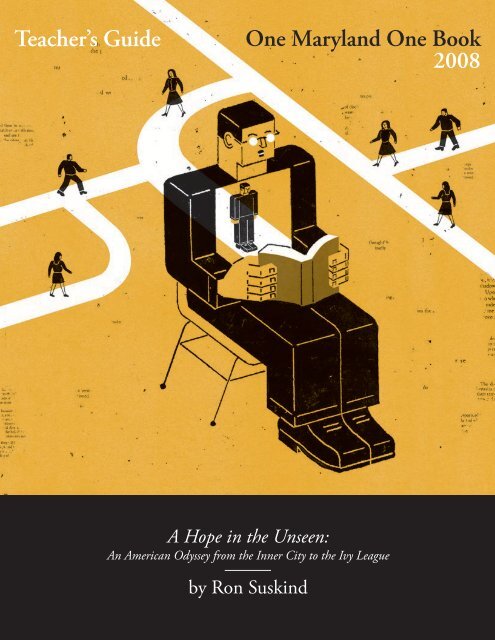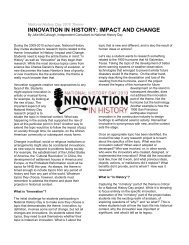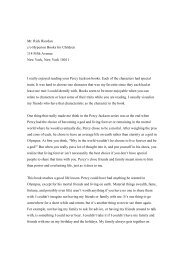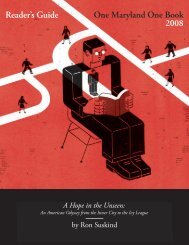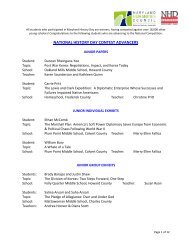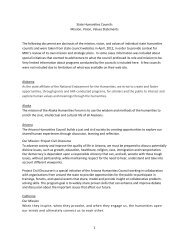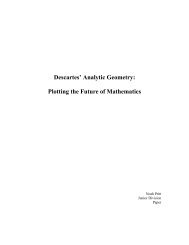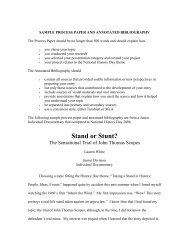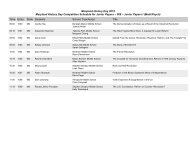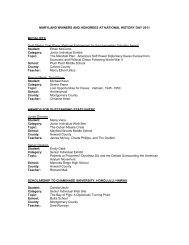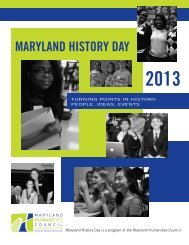A Hope in the Unseen: by Ron Suskind - Maryland Humanities Council
A Hope in the Unseen: by Ron Suskind - Maryland Humanities Council
A Hope in the Unseen: by Ron Suskind - Maryland Humanities Council
You also want an ePaper? Increase the reach of your titles
YUMPU automatically turns print PDFs into web optimized ePapers that Google loves.
One <strong>Maryland</strong> One Book 2008A <strong>Hope</strong> <strong>in</strong> <strong>the</strong> <strong>Unseen</strong>:An American Odyssey from <strong>the</strong> Inner City to <strong>the</strong> Ivy League<strong>by</strong> <strong>Ron</strong> Susk<strong>in</strong>d
Imag<strong>in</strong>e if all five million <strong>Maryland</strong>ers read <strong>the</strong>same great book at <strong>the</strong> same time.The <strong>Maryland</strong> Center for <strong>the</strong> Book, a program of <strong>the</strong> <strong>Maryland</strong><strong>Humanities</strong> <strong>Council</strong>, is pleased to launch One <strong>Maryland</strong> OneBook—<strong>Maryland</strong>’s first-ever statewide, community-centeredread<strong>in</strong>g program designed to encourage everyone <strong>in</strong> <strong>the</strong> stateto read and discuss one common book.This year’s selection—A <strong>Hope</strong> <strong>in</strong> <strong>the</strong> <strong>Unseen</strong> <strong>by</strong> <strong>Ron</strong> Susk<strong>in</strong>d—isrich and multilayered. It was selected not only because it offers<strong>the</strong> opportunity to discuss important and highly relevant topicssuch as education and socioeconomics, but also because itpresents <strong>the</strong> opportunity to talk about race and race relations<strong>in</strong> <strong>Maryland</strong> and <strong>in</strong> America—a common <strong>the</strong>me runn<strong>in</strong>g through<strong>the</strong> <strong>Maryland</strong> <strong>Humanities</strong> <strong>Council</strong>’s programm<strong>in</strong>g <strong>in</strong> 2008.Get <strong>the</strong> Book.Pick up a copy of A <strong>Hope</strong> <strong>in</strong> <strong>the</strong> <strong>Unseen</strong> at your local publiclibrary or bookstore and start up a conversation with yourfamily, friends, co-workers or even <strong>the</strong> person sitt<strong>in</strong>g next toyou on <strong>the</strong> bus or tra<strong>in</strong>. This is your chance to take a momentto have a great conversation that moves beyond <strong>the</strong> wea<strong>the</strong>r orwhat you did today.Jo<strong>in</strong> In.We <strong>in</strong>vite you to jo<strong>in</strong> Honorary Chair, <strong>Maryland</strong>’s First LadyKatie O’Malley, and millions of o<strong>the</strong>r <strong>Maryland</strong>ers at one of <strong>the</strong>many conversations and related programs happen<strong>in</strong>g around<strong>the</strong> state <strong>in</strong> August, September and October.To f<strong>in</strong>d One <strong>Maryland</strong> One Book programs <strong>in</strong> your area, go towww.onemarylandonebook.org and click on <strong>the</strong> Calendar.A <strong>Hope</strong> <strong>in</strong> <strong>the</strong> <strong>Unseen</strong>: An American Odysseyfrom <strong>the</strong> Inner City to <strong>the</strong> Ivy League <strong>by</strong> <strong>Ron</strong> Susk<strong>in</strong>d14 Chapters; 390 pgs (<strong>in</strong>clud<strong>in</strong>g Epilogue, Author’s note, and Afterword)Lexile: 1080; Read<strong>in</strong>g level: gr. 9. Updated edition © 2005ISBN 0-7679-0126-6
One <strong>Maryland</strong> One Book 2008Letter from <strong>the</strong> Honorary ChairpersonGreet<strong>in</strong>gs,On behalf of <strong>the</strong> State of <strong>Maryland</strong>, I would like to <strong>in</strong>vite you to participate <strong>in</strong> One <strong>Maryland</strong> One Book,<strong>Maryland</strong>’s first-ever statewide community read<strong>in</strong>g project. I was delighted to be asked to serve as Honorary Chairfor this momentous project because it offers an opportunity for residents <strong>in</strong> communities around <strong>the</strong> state toreconnect <strong>by</strong> open<strong>in</strong>g dialogues with one ano<strong>the</strong>r.This year’s selected book, A <strong>Hope</strong> <strong>in</strong> <strong>the</strong> <strong>Unseen</strong>: An American Odyssey from <strong>the</strong> Inner City to <strong>the</strong> Ivy League <strong>by</strong> <strong>Ron</strong>Susk<strong>in</strong>d, is one that broaches topics relevant to our daily lives, such as race, class and educational achievement. Iencourage you not only to read it, but also to talk to family, friends, neighbors and co-workers about how <strong>the</strong> issues<strong>in</strong> <strong>the</strong> book relate to your community, our state and our country.Spearheaded <strong>by</strong> <strong>the</strong> <strong>Maryland</strong> Center for <strong>the</strong> Book, this project is only possible due to <strong>the</strong> <strong>in</strong>volvement of manycommunity partners and <strong>the</strong> support of our sponsors, whom we heartily thank for <strong>the</strong>ir support. Please jo<strong>in</strong> meand many o<strong>the</strong>r <strong>Maryland</strong>ers <strong>in</strong> this read<strong>in</strong>g project <strong>by</strong> go<strong>in</strong>g to your local public library to check out a copy ofA <strong>Hope</strong> <strong>in</strong> <strong>the</strong> <strong>Unseen</strong>. I hope that it spurs conversations and thoughts to make this world a better place.Thank you for be<strong>in</strong>g a part of this very special project.S<strong>in</strong>cerely,Katie O’MalleyFirst Lady of <strong>Maryland</strong>“I encourage you notonly to read it, butalso to talk to family,friends, neighborsand co-workers abouthow <strong>the</strong> issues <strong>in</strong> <strong>the</strong>book relate to yourcommunity, our stateand our country.”1
About <strong>the</strong> BookIt is 1993, and Cedric Jenn<strong>in</strong>gs is a bright and ferociouslydeterm<strong>in</strong>ed honor student at Ballou, a high school <strong>in</strong> oneof Wash<strong>in</strong>gton D.C.’s most dangerous neighborhoods,where <strong>the</strong> dropout rate is well <strong>in</strong>to double digits and just80 students out of more than 1,350 boast an average of Bor better. At Ballou, Cedric has almost no friends. He eatslunch <strong>in</strong> a classroom most days, plow<strong>in</strong>g through <strong>the</strong> extrawork he has asked for, know<strong>in</strong>g that he’s really compet<strong>in</strong>gwith kids from o<strong>the</strong>r, harder schools. Cedric Jenn<strong>in</strong>gs’sdriv<strong>in</strong>g ambition—which is fully supported <strong>by</strong> his forcefulmo<strong>the</strong>r—is to attend a top-flight college.In September 1995, after years of near superhumandedication, he realizes that ambition when he beg<strong>in</strong>s asa freshman at Brown University. A <strong>Hope</strong> <strong>in</strong> <strong>the</strong> <strong>Unseen</strong>chronicles Cedric’s odyssey dur<strong>in</strong>g his last two years ofhigh school, follows him through his difficult first year atBrown, and tells <strong>the</strong> story of his subsequent successes <strong>in</strong>college and <strong>the</strong> world of work. 1About <strong>the</strong> AuthorPulitzer Prize-w<strong>in</strong>n<strong>in</strong>g journalistand best-sell<strong>in</strong>g author <strong>Ron</strong>Susk<strong>in</strong>d has written severalimportant works of nonfictionthat have framed nationaldebates while explor<strong>in</strong>g <strong>the</strong>complexities of <strong>the</strong> humanexperience. His first book, A<strong>Hope</strong> <strong>in</strong> <strong>the</strong> <strong>Unseen</strong>: An AmericanOdyssey from <strong>the</strong> Inner City to <strong>the</strong>Ivy League (1995), is based on a series of articles written for<strong>the</strong> Wall Street Journal that earned Susk<strong>in</strong>d <strong>the</strong> Pulitzer Prizefor Feature Writ<strong>in</strong>g <strong>in</strong> 1995.He has s<strong>in</strong>ce written two o<strong>the</strong>r best-sell<strong>in</strong>g works ofnonfiction, The One Percent Doctr<strong>in</strong>e (2006), a journeydeep <strong>in</strong>side America’s battles with violent terrorists, andThe Price of Loyalty: George W. Bush, <strong>the</strong> White Houseand <strong>the</strong> Education of Paul O’Neill (2004), both criticallyacclaimedworks.Mr. Susk<strong>in</strong>d currently writes for various nationalmagaz<strong>in</strong>es, <strong>in</strong>clud<strong>in</strong>g Time Magaz<strong>in</strong>e, The New York TimesMagaz<strong>in</strong>e, Esquire and <strong>the</strong> Wall Street Journal, appears onnetwork television, and spends summers as a Dist<strong>in</strong>guishedVisit<strong>in</strong>g Scholar at Dartmouth College. He is a graduateof <strong>the</strong> University of Virg<strong>in</strong>ia and Columbia University’sGraduate School of Journalism, and lives <strong>in</strong> Wash<strong>in</strong>gton,D.C., with his wife, Cornelia Kennedy Susk<strong>in</strong>d, and <strong>the</strong>irtwo sons, Walter and Owen.About Cedric Jenn<strong>in</strong>gsCedric Jenn<strong>in</strong>gs was born <strong>in</strong> 1977 and raised <strong>in</strong> one of<strong>the</strong> most depressed and dangerous neighborhoods <strong>in</strong>Wash<strong>in</strong>gton, D.C.’s Sou<strong>the</strong>ast section. His fa<strong>the</strong>r was afrequently absent and jailed drug addict, while his mo<strong>the</strong>r,Barbara Jenn<strong>in</strong>gs, was a devout church woman who qui<strong>the</strong>r government job and went on welfare for several yearsto devote her time to rais<strong>in</strong>g Cedric.With his mo<strong>the</strong>r’s support and good grades <strong>in</strong> school,Cedric went on to complete a childhood dream andattended an Ivy League school. After graduat<strong>in</strong>g fromBrown <strong>in</strong> 1999, Cedric received his Master of Education atHarvard University and a Master of Social Work <strong>in</strong> 2003from <strong>the</strong> University of Michigan. Presently, he speaks atschools and universities across <strong>the</strong> country on issues <strong>in</strong>education and youth advocacy. He plans to eventually earna doctorate degree and become a psycho<strong>the</strong>rapist work<strong>in</strong>gwith disadvantaged youth.IntroductionA <strong>Hope</strong> <strong>in</strong> <strong>the</strong> <strong>Unseen</strong> chronicles Cedric Lavar Jenn<strong>in</strong>gs’sjourney through his last two years at Ballou High School—“where only 69 girls and 12 boys out of 1,389 enrolledhere have managed a B average or better”—through hisfirst year at <strong>the</strong> prestigious Brown University. This story isnot about a poverty-stricken prodigy who fights to take hisplace among his <strong>in</strong>tellectual equals. Instead it’s about anAfrican American boy from “<strong>the</strong> most troubled and violentschool <strong>in</strong> <strong>the</strong> blighted sou<strong>the</strong>ast corner of Wash<strong>in</strong>gton,D.C.” with a 3.3 average and a 960 SAT score who, with<strong>the</strong> support of his mo<strong>the</strong>r, his church, and his pride,makes education <strong>the</strong> choice that will take him beyond <strong>the</strong>constra<strong>in</strong>ts of poverty.This is truly an American odyssey filled with struggles,hardships, awaken<strong>in</strong>gs and achievement; it is <strong>the</strong>commonality of <strong>the</strong>se elements, which crosses race,nationality, and gender, that touches <strong>the</strong> readers. CedricJenn<strong>in</strong>gs is like most high school students—filled withdoubt, contradictions, anger, and frustration—but hewas motivated ra<strong>the</strong>r than pulled down <strong>by</strong> <strong>the</strong> weight ofpoverty and <strong>the</strong> bestiality of his neighborhood. A <strong>Hope</strong> <strong>in</strong><strong>the</strong> <strong>Unseen</strong> is a contemporary odyssey which all studentscan relate to on some level and which adults can whollyappreciate.1 From <strong>the</strong> back cover2
One <strong>Maryland</strong> One Book 2008MSDE Core Learn<strong>in</strong>g Goals - EnglishGOAL 1: READING, REVIEWING ANDRESPONDING TO TEXTThe student will demonstrate <strong>the</strong> ability to respond toa text <strong>by</strong> employ<strong>in</strong>g personal experiences and criticalanalysis.EXPECTATION 1.1 The student will use effective strategiesbefore, dur<strong>in</strong>g, and after read<strong>in</strong>g, view<strong>in</strong>g, and listen<strong>in</strong>g toself-selected and assigned materials.INDICATOR 1.1.1 The student will use pre-read<strong>in</strong>gstrategies appropriate to both <strong>the</strong> text and purposefor read<strong>in</strong>g <strong>by</strong> survey<strong>in</strong>g <strong>the</strong> text, access<strong>in</strong>g priorknowledge, formulat<strong>in</strong>g questions, sett<strong>in</strong>g purpose(s),and mak<strong>in</strong>g predictions.INDICATOR 1.1.2 The student will use dur<strong>in</strong>g-read<strong>in</strong>gstrategies appropriate to both <strong>the</strong> text and purpose forread<strong>in</strong>g <strong>by</strong> visualiz<strong>in</strong>g, mak<strong>in</strong>g connections, and us<strong>in</strong>gfix-up strategies such as re-read<strong>in</strong>g, question<strong>in</strong>g, andsummariz<strong>in</strong>g.INDICATOR 1.1.3 The student will use after-read<strong>in</strong>gstrategies appropriate to both <strong>the</strong> text and purposefor read<strong>in</strong>g <strong>by</strong> summariz<strong>in</strong>g, compar<strong>in</strong>g, contrast<strong>in</strong>g,syn<strong>the</strong>siz<strong>in</strong>g, draw<strong>in</strong>g conclusions, and validat<strong>in</strong>g <strong>the</strong>purpose for read<strong>in</strong>g.EXPECTATION 1.2 The student will construct, exam<strong>in</strong>e, andextend mean<strong>in</strong>g of traditional and contemporary worksrecognized as hav<strong>in</strong>g significant literary merit.INDICATOR 1.2.1 The student will consider <strong>the</strong>contributions of plot, character, sett<strong>in</strong>g, conflict, andpo<strong>in</strong>t of view when construct<strong>in</strong>g <strong>the</strong> mean<strong>in</strong>g of atext.INDICATOR 1.2.2 The student will determ<strong>in</strong>e how <strong>the</strong>speaker, organization, sentence structure, word choice,rhythm, and imagery reveal an author’s purpose.INDICATOR 1.2.3 The student will expla<strong>in</strong> <strong>the</strong>effectiveness of stylistic elements <strong>in</strong> a text thatcommunicate an author’s purpose.INDICATOR 1.2.5 The student will extend or fur<strong>the</strong>rdevelop mean<strong>in</strong>g <strong>by</strong> expla<strong>in</strong><strong>in</strong>g <strong>the</strong> implications of <strong>the</strong>text for <strong>the</strong> reader or contemporary society.EXPECTATION 1.3 The student will expla<strong>in</strong> and giveevidence to support perceptions about pr<strong>in</strong>t and nonpr<strong>in</strong>tworks.INDICATOR 1.3.1 The student will expla<strong>in</strong> howlanguage and textual devices create mean<strong>in</strong>g.INDICATOR 1.3.5 The student will expla<strong>in</strong> howcommon and universal experiences serve as <strong>the</strong> sourceof literary <strong>the</strong>mes that cross time and cultures.GOAL 4: EVALUATING THE CONTENT,ORGANIZATION, AND LANGUAGE USE OF TEXTSThe student will demonstrate <strong>the</strong> ability to evaluate <strong>the</strong>content, organization, and language use of texts.EXPECTATION 4.1 The student will describe <strong>the</strong> effect thata given text, heard or read, has on a listener or reader.INDICATOR 4.1.1 The student will state and expla<strong>in</strong> apersonal response to a given text.EXPECTATION 4.2 The student will assess <strong>the</strong> effectivenessof choice of details, organizational pattern, word choice,syntax, use of figurative language, and rhetorical devices.INDICATOR 4.2.1 The student will assess <strong>the</strong>effectiveness of diction that reveals an author’spurpose.INDICATOR 4.2.2 The student will expla<strong>in</strong> how <strong>the</strong>specific language and expression used <strong>by</strong> <strong>the</strong> writer orspeaker affects reader or listener response.Chapter SummariesFreehttp://mb.sparknotes.com/mb.epl?b=2386&m=1183783&t=336628Fee to download ($6.95), but extensivehttp://monkeynote.stores.yahoo.net/hop<strong>in</strong>un<strong>by</strong>ron.html3
Before Read<strong>in</strong>gIn an effort to provide common background knowledgeand to promote pre-read<strong>in</strong>g discussion, a PowerPo<strong>in</strong>t isprovided at <strong>the</strong> One <strong>Maryland</strong> One Book website, www.onemarylandonebook.org. Click on Teacher Resources.Teacher’s Note: The follow<strong>in</strong>g scenes as written representan effort <strong>by</strong> <strong>the</strong> author to convey <strong>the</strong> reality of Cedric’sstory <strong>in</strong> <strong>the</strong> most accurate way. These potentiallyobjectionable scenes are found <strong>in</strong> <strong>the</strong> book as follows:• Page 11: Explicit quote from crack dealer• Page 18: Girl’s cover for cheat<strong>in</strong>g from Cedric <strong>in</strong>cludesexplicit sexual reference• Page 57: Objectionable language• Page 126: Objectionable language• Page 200: Discussion of sexual acts• Page 218: Reference to homosexual act• Pages 210, 225, 305, 350, 351: Objectionable languageImportant Characters• Cedric Lavar Jenn<strong>in</strong>gs – <strong>the</strong> protagonist• Barbara Jenn<strong>in</strong>gs – Cedric’s mo<strong>the</strong>r• Cedric Gilliam – Cedric’s fa<strong>the</strong>r• Mr. Clarence Taylor – Cedric’s chemistry teacher• LaTisha Williams – ano<strong>the</strong>r outsider at Ballou andCedric’s friend• Phillip Atk<strong>in</strong>s – Cedric’s Ballou classmate who madedifferent choices• Professor Trill<strong>in</strong>g – white faculty director ofMassachusetts Institute of Technology’s MITES(M<strong>in</strong>ority Introduction to Eng<strong>in</strong>eer<strong>in</strong>g and Science)program• Bishop C.L. Long – Pastor of <strong>the</strong> church Barbara andCedric attend• Donald Korb – Cedric’s benefactor• Rob Burton – Cedric’s roommate at Brown University• Zayd Dohrn – a friend at Brown• Ch<strong>in</strong>iqua Milligan – <strong>the</strong> only o<strong>the</strong>r African American<strong>in</strong> Cedric’s freshman dorm at BrownRead<strong>in</strong>g, Vocabulary & Discussion QuestionsASSIGNMENT #1Pages 1-50Vocabulary: gamecock, kufi (pg. 1)gauntlet (pg. 5)call and response (pg. 6)temerity (pg. 19)affectations (pg. 20)abeyance (pg. 25)Discussion Questions:1. What is <strong>the</strong> “crab/bucket syndrome” (pg. 17) and is itvisible at our school?2. Compare and contrast Cedric with <strong>the</strong> o<strong>the</strong>r students athis school. (pg. 18)3. Why does he impose a self-exile? (pg. 18) Would you ifyou were Cedric?4. What does “busy python of traffic” mean? (pg. 31)What k<strong>in</strong>d of figurative language is that phrase?5. Why do you th<strong>in</strong>k Cedric and his mo<strong>the</strong>r reacted <strong>the</strong>way <strong>the</strong>y did to <strong>the</strong> news that Cedric couldn’t return toJefferson? (pg. 40) Would your parents react <strong>the</strong> sameway if you were told you couldn’t return to this school?6. Compare and contrast Cedric’s anxieties about be<strong>in</strong>gat a crossroads to that of o<strong>the</strong>r college-bound students(you or someone you know). (pg. 44)4
One <strong>Maryland</strong> One Book 2008ASSIGNMENT #2Pages 51-100 (end of chapter 4)Vocabulary: slaloms (pg. 65)cacophony (pg. 74)novitiate, visceral (pg. 79)anomaly (pg. 83)aphorism (pg. 85)Discussion Questions:1. How does your school’s attitude about homeworkcompare with <strong>the</strong> students’ attitude at Ballou? Withwhom do you agree, Cedric or <strong>the</strong> SAT Prep teacher?(pg. 59)2. Is <strong>the</strong>re any truth <strong>in</strong> Torrence’s explanation for Cedric’sunhapp<strong>in</strong>ess? (pg. 87)3. Are Ramsey’s concerns about hav<strong>in</strong>g a white directorfor a m<strong>in</strong>ority enrichment program valid? (pg. 92)4. S<strong>in</strong>ce Cedric struggled much of <strong>the</strong> time that he was<strong>in</strong> <strong>the</strong> MITES program, should he have been surprisedwhen Trill<strong>in</strong>g told him he was not MIT material? Washe right to call Trill<strong>in</strong>g a racist? (pg. 97)5. What advantages would Cedric have to improve hisSAT score if he were at your school? Why do you th<strong>in</strong>kthose programs aren’t available at Ballou?6. Expla<strong>in</strong> <strong>the</strong> irony between Cedric feel<strong>in</strong>g comfortableat Ballou and yet hat<strong>in</strong>g it so much. (pg. 100)ASSIGNMENT #3Pages 101-158 (end of chapter 6)Vocabulary: self-deprecat<strong>in</strong>g (pg. 103)behest (pg. 117)naysayer (pg. 119)rhetorical (pg. 122)anomalous (pg. 124)<strong>in</strong>fidel (pg. 132)arboretum (pg. 142)bulwark, phalanx (pg.149)Discussion Questions:1. How does James Davis’s experience at Ballou differfrom Cedric’s? (pg.103)2. Do you th<strong>in</strong>k Cedric’s conversation with ClarenceThomas impacted him? Why or why not? (pgs. 118-122)3. Should <strong>the</strong> valedictorian and salutatorian be allowed tospeak about any topic at graduation? If you were <strong>the</strong>pr<strong>in</strong>cipal, would you object to Cedric’s speech about“Dreambusters?”4. Why do you th<strong>in</strong>k <strong>the</strong> last few weeks of school are sodifficult for Cedric?5. How is Cedric’s graduation speech similar to his s<strong>in</strong>g<strong>in</strong>g<strong>in</strong> front of <strong>the</strong> church as a child? (pg. 137) What doesit say about Cedric?6. Consider Barbara’s def<strong>in</strong>ition of a man. (pg. 145) Is thisa realistic def<strong>in</strong>ition? Expla<strong>in</strong>. Accord<strong>in</strong>g to Barbara’sdef<strong>in</strong>ition, has Cedric become a man yet?ASSIGNMENT #4Pages 159- <strong>the</strong> break on 208Vocabulary: nascent (pg. 162)embryonic, caverous (pg. 169)preemptive (pg. 170)parlance (pg. 172)portentous (pg. 174)diatribes (pg. 175)exurb (pg. 178)mawkishly (pg. 180)anal-retentive (pg. 183)parsed (pg. 191)Discussion Questions:1. Though Cedric says, “I, uh, got a 960…I’m notashamed of it or anyth<strong>in</strong>g,” how do you th<strong>in</strong>k he feelshear<strong>in</strong>g everyone else’s SAT scores? Could <strong>the</strong> disparitybecome what he “pushes aga<strong>in</strong>st?” (pg. 170)2. Susk<strong>in</strong>d’s coverage of Elie Wiesel’s speech to Brownstudents is almost dismissive. Indeed, <strong>the</strong>re is nocomment from Cedric at all. What are possible reasonswhy Cedric could be unimpressed and unmoved <strong>by</strong>Wiesel? (pg. 187)3. Do you th<strong>in</strong>k <strong>the</strong> differences between Cedric and hisroommate Rob are due to <strong>the</strong>ir race? Why or why not?4. Why would <strong>the</strong> open curriculum at Brown benefitstudents like Cedric? (pg. 173)5. Why was Cedric’s response at <strong>the</strong> diversity orientation“lost <strong>in</strong> <strong>the</strong> thicket?” Do you agree with him or not?(pg. 177)6. How do <strong>the</strong> two white professors’ feel<strong>in</strong>gs aboutaffirmative action differ from from Cedric’s?Who’s right?5
ASSIGNMENT #5Pages 208-261 (end of chapter 10)Vocabulary: ethos (pg. 220)anachronistic (pg. 223)addendum (pg. 243)piqued (pg. 246)patrician (pg. 248)languid (pg. 255)assimilationist (pg. 258)juxtaposition (pg. 260)Discussion Questions:1. Why do you th<strong>in</strong>k Susk<strong>in</strong>d <strong>in</strong>cludes so much<strong>in</strong>formation about Cedric’s fa<strong>the</strong>r even though he has solittle contact with his son?2. Was Barbara wise or foolish to make <strong>the</strong> trip to Brownfor parents’ weekend? (pg. 227)3. Why is Cedric so surprised that Zayd didn’t grow up tohate black people? (pg. 246)4. Who made <strong>the</strong> strongest impact on Cedric when he wasat Mr. Korb’s house for Thanksgiv<strong>in</strong>g? Why? (pg. 249)5. What does Professor James mean when he says Cedricis “not accommodationist” and is “culturally fixed?”Would you agree or disagree? Are <strong>the</strong>se descriptionsnegative or positive? (pg. 260)ASSIGNMENT #6Pages 262-303 (end of chapter 12)Vocabulary: candor (pg. 263)cont<strong>in</strong>gency (pg. 266)jocular (pg. 272)cursory, acerbic (pg. 282)Discussion Questions:1. Read Cedric’s mus<strong>in</strong>gs on pages 274 and 275. What is<strong>the</strong> difference between pride and confidence? Whichdoes Cedric possess?2. What contradiction has been a “real shock” to Cedric?(pg. 275)3. Why is it harder for Cedric to be friends with Zaydthan it is for Zayd to be friends with Cedric? (pgs. 277-280)4. Susk<strong>in</strong>d describes <strong>the</strong> groups at Brown. (pgs. 292-293)How are such divisions positive? How are <strong>the</strong>y negative?5. What evidence does Susk<strong>in</strong>d provide that Cedric ischang<strong>in</strong>g?6. What does Wakeford mean when he tells Cedric, “Thekey […] is to put your outrage <strong>in</strong> a place where you canget at it when you need to, but not have it bubble up somuch, especially when you’re asked to embrace new ideasor expla<strong>in</strong> what you observe to people who share none ofyour experiences?” (pg. 303)ASSIGNMENT #7Pages 304-361 (end of chapter 14)Vocabulary: imprimatur (pg. 307)proprietary (pg. 315)admonitions (pg. 332)entropic (pg. 334)beef<strong>in</strong>’ (pg. 353)extricate (pg. 359)Discussion Questions:1. What does Cedric’s l<strong>in</strong>e of poetry, “Let <strong>the</strong> colorsrun…” mean to you? Do you like it as much as Zaydand Cedric? (pg. 305)2. Ch<strong>in</strong>iqua says, <strong>in</strong> reference to music and culture, “Youhave to have grown up with it like us, to really know it.”(pg. 315) Do you agree or disagree? If this is true, whatdoes it tell us about cross-cultural relationships? Doesmulticultural education <strong>the</strong>n not have a purpose?3. What are some of <strong>the</strong> elements of Cedric’s personalitythat helped him make it through his first year at Brown?4. Why do you th<strong>in</strong>k Cedric and Rob had so manydifficulties as roommates?5. How is Barbara’s pride different from Cedric’s pride?6. Do you th<strong>in</strong>k that Cedric has become a man <strong>by</strong> <strong>the</strong> endof <strong>the</strong> story? Why or why not? Use situations from <strong>the</strong>story to justify your op<strong>in</strong>ion.ASSIGNMENT #8Pages 362-end (epilogue, author’s note, afterword)No vocabularyNo specific discussion questionsJust readAfter Read<strong>in</strong>g• Take time to return to <strong>the</strong> class questions createddur<strong>in</strong>g <strong>the</strong> Before Read<strong>in</strong>g PowerPo<strong>in</strong>t (found at www.onemarylandonebook.org under Teacher Resources).• Allow students small group time to discern whe<strong>the</strong>r <strong>the</strong>story, epilogue, author’s note, and afterword were ableto answer all <strong>the</strong> questions <strong>in</strong>itially posed.• Erase all questions that were answered and see if any of<strong>the</strong> Extension projects supply <strong>the</strong> answers.6
One <strong>Maryland</strong> One Book 2008Extension Topics/Projects1. CharacterizationsGo to www.onemarylandonebook.org, click on TeacherResources, <strong>the</strong>n After Read<strong>in</strong>g Activity to pr<strong>in</strong>t copiesof an exercise where students demonstrate <strong>the</strong>irunderstand<strong>in</strong>g of people connected with A <strong>Hope</strong> <strong>in</strong> <strong>the</strong><strong>Unseen</strong>.2. Impact of racism on students <strong>in</strong> your school• As a class, create a survey of questions to ask <strong>the</strong>m<strong>in</strong>ority students <strong>in</strong> your school. One team of studentscompletes <strong>the</strong> survey, posts some of <strong>the</strong> most poignantquotes around <strong>the</strong> classroom, and turns <strong>the</strong> results <strong>in</strong>toa PowerPo<strong>in</strong>t or a research paper.• Watch <strong>the</strong> movie “The Great Debaters.” Have studentsdeterm<strong>in</strong>e changes that have occurred <strong>in</strong> <strong>the</strong> U.S.between 1935 when <strong>the</strong> movie takes place and 60 yearslater when A <strong>Hope</strong> <strong>in</strong> <strong>the</strong> <strong>Unseen</strong> takes place.3. Affirmative Action/Diversity Issues• One team of students researches <strong>the</strong> history and <strong>the</strong>pros of Affirmative Action; ano<strong>the</strong>r team researches <strong>the</strong>cons. Toge<strong>the</strong>r <strong>the</strong>y present a debate <strong>in</strong> front of<strong>the</strong> class.• Invite <strong>the</strong> ESOL teacher to visit your class and discuss<strong>the</strong> trials that ESL students face.• A team researches <strong>the</strong> history of affirmative action,reverse discrim<strong>in</strong>ation, and Title IX and presents amultimedia presentation.• One team rereads <strong>the</strong> description of <strong>the</strong> MITESprogram (pgs. 91-93) and <strong>the</strong>n lists <strong>the</strong> pros and cons of<strong>the</strong> program. The team <strong>the</strong>n comes up with suggestionsthat would elim<strong>in</strong>ate <strong>the</strong> weaknesses.• One team researches Clarence Thomas’s record asa Supreme Court justice and determ<strong>in</strong>es how hisdecisions on <strong>the</strong> bench and <strong>in</strong> <strong>the</strong> runn<strong>in</strong>g of his officedemonstrate his professional success or failure <strong>in</strong> liv<strong>in</strong>gup to <strong>the</strong> advice he gave Cedric.4. The importance of faith <strong>in</strong> one’s life• One team surveys elders, one team surveys classmates,one team surveys younger children on <strong>the</strong> topic.Quotes are posted around <strong>the</strong> classroom and <strong>the</strong> threeteams create a news show about <strong>the</strong> importance (orunimportance) of faith <strong>in</strong> your town.• Invite an African American pastor to come talk toyour class about <strong>the</strong> tradition of faith <strong>in</strong> <strong>the</strong> blackcommunity. Prior to <strong>the</strong> visit, allow students to createquestions to ask.5. Poverty• One team researches <strong>the</strong> impact of urban poverty onstudents <strong>the</strong>ir age.• One team contacts social services <strong>in</strong> your town andf<strong>in</strong>ds out what constitutes “poverty” <strong>in</strong> your town andwhat services are available to <strong>the</strong> poor. Students present<strong>the</strong>ir f<strong>in</strong>d<strong>in</strong>gs to <strong>the</strong> class.• One team plans four days of meals for two on $12.50.Someth<strong>in</strong>g must be eaten each day though three mealsa day will be unlikely. What is <strong>the</strong> most nutritious mealthat can be made, and <strong>the</strong> most fill<strong>in</strong>g?O<strong>the</strong>r Helpful ResourcesAuthor’s websitehttp://www.ronsusk<strong>in</strong>d.com/about/Interview with Susk<strong>in</strong>dhttp://discuss.wash<strong>in</strong>gtonpost.com/wp-srv/zforum/02/life360_010402.htmAudio <strong>in</strong>terview with Susk<strong>in</strong>d and Jenn<strong>in</strong>gs.www.randomhouse.com/boldtype/0798/susk<strong>in</strong>d/<strong>in</strong>terview.htmlMay ’06 Jenn<strong>in</strong>gs refl ection on Brownhttp://media.www.browndailyherald.com/media/storage/paper472/news/2006/05/25/Features/hope-On.Campus-2013815.shtmlSept. ’07 news article about Jenn<strong>in</strong>gs speech at Eastern Ill<strong>in</strong>ois U.http://media.www.dennews.com/media/storage/paper309/news/2007/09/25/News/Jenn<strong>in</strong>gs.Speaks.About.Real.<strong>Hope</strong>-2988938.shtmlInterview with Jenn<strong>in</strong>gs about his faithhttp://explorefaith.org/faithStories/cedric.htmlLBJ’s 1965 commencement speech at Howardhttp://www.lbjlib.utexas.edu/johnson/archives.hom/speeches.hom/650604.aspPublisher’s Teacher Guidehttp://www.randomhouse.com/acmart/catalog/display.pperl?isbn=9780767901260&view=tg7
Notes8
Created <strong>by</strong> S.P. Mundy April 2008 ©Portions of this Guide have beenrepr<strong>in</strong>ted with permission fromRandom House Publish<strong>in</strong>g, Inc.Cover art © 2008 David Plunkert
108 West Centre StreetBaltimore, MD 21201(410) 685-0095www.onemarylandonebook.orgSponsorsOne <strong>Maryland</strong> One Book is coord<strong>in</strong>ated <strong>by</strong> <strong>the</strong> <strong>Maryland</strong> Center for <strong>the</strong> Book, a program of <strong>the</strong> <strong>Maryland</strong> <strong>Humanities</strong> <strong>Council</strong>,<strong>in</strong> partnership with Enoch Pratt Free Library, <strong>the</strong> <strong>Maryland</strong> State Department of Education, and <strong>the</strong> Division of LibraryDevelopment & Services.One <strong>Maryland</strong> One Book is funded <strong>by</strong> <strong>the</strong> Institute of Museum and Library Services, LSTA grant funds, through <strong>the</strong> Division ofLibrary Development & Services, <strong>Maryland</strong> State Department of Education.Additional program support is made possible through <strong>the</strong> generosity of The Bank of America Foundation.


